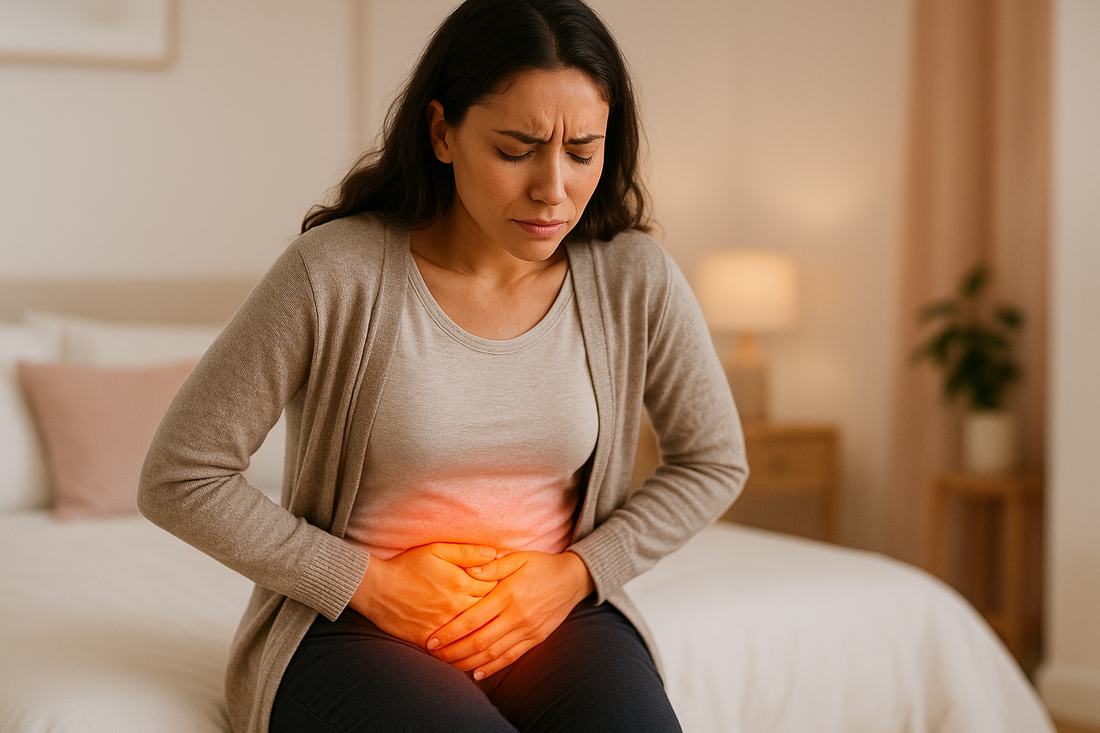
The Link Between Hormones and Endometriosis Explained
Share
Endometriosis affects approximately 10% (around 190 million) women and girls of reproductive age globally. It is a chronic and painful condition in which tissue similar to the lining of the uterus (the endometrium) grows outside the uterus. These misplaced tissues respond to hormonal changes during the menstrual cycle, leading to pain, inflammation, and sometimes infertility.
Women with endometriosis often experience:
- Severe pain during periods (dysmenorrhea)
- Pain during sexual intercourse
- Painful bowel movements or urination
- Chronic pelvic pain
- Abdominal bloating and nausea
- Fatigue and emotional distress such as anxiety or depression
Despite its widespread prevalence, diagnosis and effective treatment remain challenging, especially in low- and middle-income countries, where awareness and specialized care are limited. Although there’s currently no known cure for endometriosis, timely diagnosis, hormonal management, and lifestyle changes can significantly improve quality of life.
Understanding Endometriosis
Endometriosis occurs when endometrial-like tissue grows outside the uterus — on the ovaries, fallopian tubes, outer surfaces of the uterus or intestines, and even in the pelvic cavity. These tissues act just like normal uterine lining, thickening, breaking down, and bleeding with each menstrual cycle. But unlike the normal uterine lining, this blood has no way to exit the body, leading to internal bleeding, inflammation, scar tissue formation (adhesions), and cysts.
Common Sites of Endometriotic Growth
- Ovaries (forming ovarian cysts called endometriomas)
- Fallopian tubes
- Uterus’ outer surface
- Pelvic walls
- Intestines or bladder in severe cases
The condition can range from mild to severe, depending on the extent of the growth and depth of tissue invasion. Severity doesn’t always correlate with the level of pain — some women with mild endometriosis have severe symptoms, while others with extensive disease may experience minimal discomfort.
The Role of Hormones in Endometriosis
Hormones are at the heart of endometriosis. The female reproductive hormones — estrogen and progesterone — play a central role in controlling the menstrual cycle. However, in women with endometriosis, hormonal imbalances, particularly estrogen dominance, fuel the condition.
1. Estrogen: The Main Culprit
Estrogen stimulates the growth and maintenance of endometrial tissue. In endometriosis, estrogen levels are often higher or remain active for longer durations, even outside the uterus. This excessive estrogenic activity:
- Encourages abnormal tissue growth
- Triggers inflammation
- Increases nerve sensitivity (causing pain)
- Promotes angiogenesis (formation of new blood vessels that nourish endometrial tissue)
Researchers also found that endometriotic cells themselves can produce local estrogen, amplifying the problem.
2. Progesterone Resistance
Normally, progesterone balances estrogen’s effects and stabilizes the endometrial lining. However, in women with endometriosis, tissues often become resistant to progesterone. This means:
- Progesterone can’t effectively suppress tissue overgrowth
- The anti-inflammatory benefits of progesterone are lost
- Endometriotic tissues become more reactive and inflammatory
This imbalance — high estrogen + low progesterone response — creates a hormonal environment that allows the disease to progress.
3. Other Hormones and Endocrine Factors
Apart from estrogen and progesterone, other hormones like prostaglandins, cortisol, and insulin play secondary roles:
- Prostaglandins (inflammatory compounds) are elevated, leading to more pain and cramping.
- Cortisol dysregulation (stress hormone) may worsen inflammation and fatigue.
- Insulin resistance in some cases contributes to hormonal disruption and inflammation.
Together, these hormonal imbalances form a cycle of inflammation, pain, and tissue growth that defines endometriosis.
What Causes Hormonal Imbalance in Endometriosis?
While the exact cause is unknown, several factors contribute to hormonal imbalance and disease progression:
- Genetic predisposition: A family history of endometriosis increases risk.
- Environmental toxins: Chemicals like dioxins and PCBs can mimic estrogen and disrupt hormonal balance.
- Stress: Chronic stress increases cortisol and disturbs reproductive hormones.
- Diet and lifestyle: High intake of processed foods, sugar, and alcohol can boost estrogen activity.
- Obesity: Fat tissue produces estrogen, adding to the hormonal load.
Understanding and managing these factors can help reduce flare-ups and improve hormonal regulation.
Symptoms of Hormonal Imbalance in Endometriosis
When hormones are out of balance, symptoms become more severe. Common hormonal-related symptoms include:
- Irregular or heavy periods
- Mood swings and irritability
- Weight gain around the abdomen
- Breast tenderness
- Fatigue and low energy
- Severe menstrual cramps
Tracking menstrual cycles, pain patterns, and mood changes can help identify hormonal irregularities early.
How Hormones Influence Fertility in Endometriosis
One of the most distressing effects of endometriosis is infertility. Hormonal imbalance disrupts the delicate process of ovulation and implantation.
- High estrogen and inflammation can impair egg quality.
- Scar tissue may block fallopian tubes, preventing fertilization.
- Progesterone resistance affects the uterine lining’s ability to support implantation.
Many women discover they have endometriosis only when they face difficulty conceiving. Managing hormones through medical or natural approaches can often restore fertility potential.
Diagnosis and Hormone Testing
Diagnosing endometriosis often involves:
- Pelvic examination
- Ultrasound or MRI scans to detect cysts or adhesions
- Laparoscopy, a minor surgical procedure to visually confirm endometrial growth
- Hormone testing to evaluate estrogen, progesterone, and thyroid levels
Early diagnosis can significantly improve symptom control and prevent disease progression.
Treatment Options: Balancing Hormones
The goal of treatment is not to cure but to manage pain, control tissue growth, and balance hormones.
1. Hormonal Therapies
- Birth control pills: Regulate estrogen and progesterone to suppress ovulation.
- Progestin therapy: Reduces estrogen stimulation and slows tissue growth.
- Gonadotropin-releasing hormone (GnRH) agonists: Induce a temporary menopausal state to shrink lesions.
- Aromatase inhibitors: Block estrogen production in tissues.
These treatments are effective but may have side effects like bone loss, mood swings, or hot flashes.
2. Pain Management
Non-steroidal anti-inflammatory drugs (NSAIDs) help relieve pain but don’t address the underlying hormonal issue.
3. Surgery
In severe cases, laparoscopic surgery can remove endometrial tissue, cysts, and adhesions. Surgery is often combined with hormonal therapy to prevent recurrence.
Lifestyle and Diet for Hormonal Balance
Lifestyle changes play a vital role in managing endometriosis symptoms and supporting hormonal harmony.
Dietary Recommendations
- Increase fiber: Helps eliminate excess estrogen (found in fruits, vegetables, and whole grains).
- Consume omega-3 fatty acids: Found in flaxseeds, chia seeds, and fatty fish to reduce inflammation.
- Limit red meat and processed foods: These can elevate estrogen levels and inflammatory markers.
- Reduce caffeine and alcohol: Both can increase estrogen activity and worsen pain.
- Stay hydrated: Flushes toxins and aids hormonal metabolism.
Exercise and Stress Management
Regular physical activity helps regulate hormones and reduce pain by improving blood flow and lowering cortisol levels.
Practices like yoga, meditation, and deep breathing can help manage emotional stress, which often worsens symptoms.
Ayurvedic Perspective on Endometriosis
From an Ayurvedic standpoint, endometriosis is linked to an imbalance of Vata and Pitta doshas.
- Vata imbalance leads to pain and irregular movement of menstrual flow.
- Pitta imbalance causes inflammation and excessive tissue growth.
Ayurveda emphasizes restoring balance through:
- Herbal remedies: Such as Ashoka (Saraca indica), Lodhra (Symplocos racemosa), and Turmeric (Curcuma longa) to reduce inflammation and balance hormones.
- Detoxification (Panchakarma): Helps cleanse the body of toxins (ama) that aggravate hormonal imbalance.
- Dietary regulation: Avoiding spicy, oily foods and favoring cooling and easily digestible meals.
- Lifestyle changes: Regular sleep, stress management, and yoga therapy support reproductive health.
These approaches, when combined with medical management, can provide long-term relief and hormonal stability.
For regular health tips & updates visit Ayushakti’s Social Media Pages:
- Facebook – Ayushakti Ayurved | Facebook
- Instagram – Ayushakti Ayurved (@ayushakti)
- Pinterest – ayushaktiayurveda
Get all the updates about Ayushakti Ayurved on WhatsApp directly. Click here to Join our WhatsApp Channel
Ayushakti's mission is to help people in every way possible. Our Ayurvedic experts are available to give you a consultation either over the phone or through a video consultation. We recommend customised diets, home remedies, and detox therapies to help you recover from health problems. Book your consultation now!
If you would like to know the location or visit one of our centres, please click here: https://www.ayushakti.com/home/p/contact
For more information, write to us at info@ayushakti.com or call our toll-free numbers: 18002663001 (India) and +18002800906 (Global).
Blog Author: Dr. Ramchandra Konduskar
Expert Review: Dr Smita Pankaj Naram
Co-Founder, Ayushakti Ayurved Pvt Ltd
Disclaimer: This blog is for educational purposes only. Please consult an Ayurvedic practitioner before trying or consuming any medicines, home remedies or treatments mentioned in this blog. The information provided is not intended to diagnose, treat, cure, or prevent any disease.





